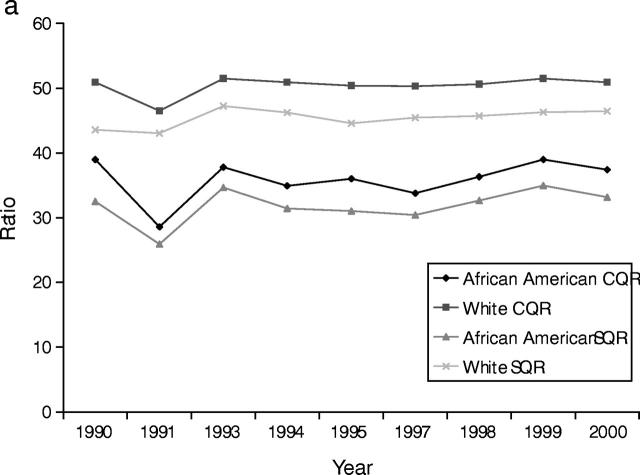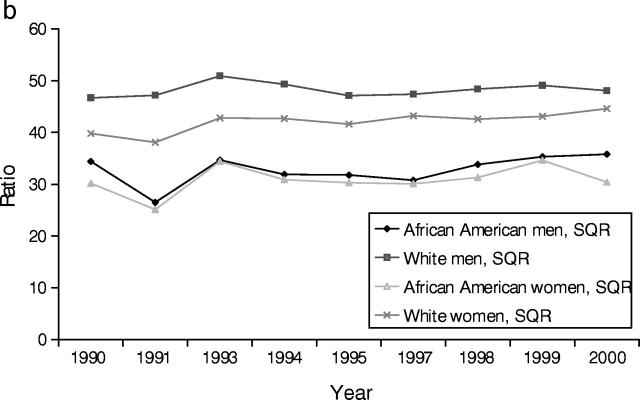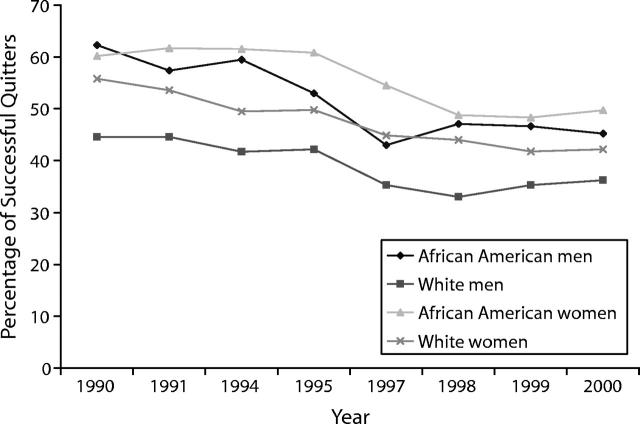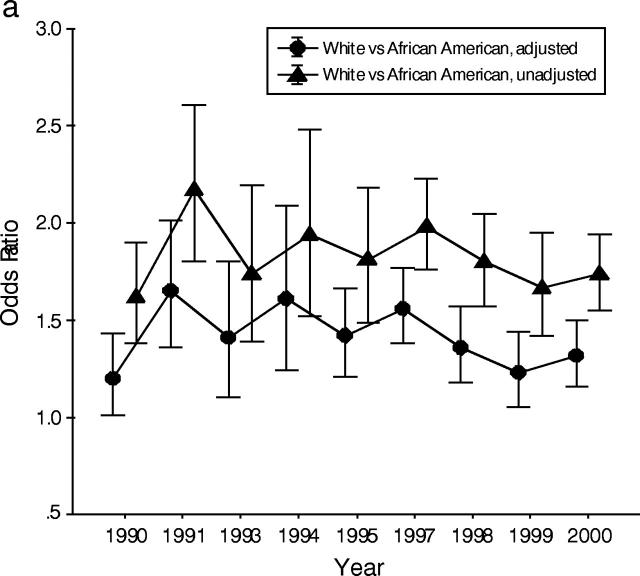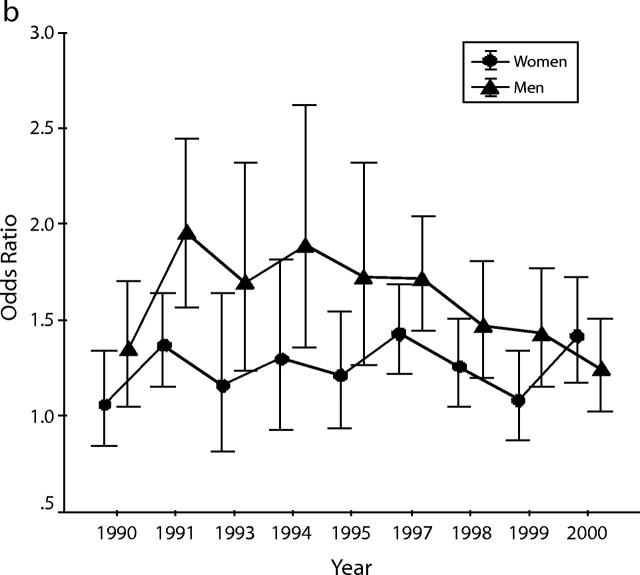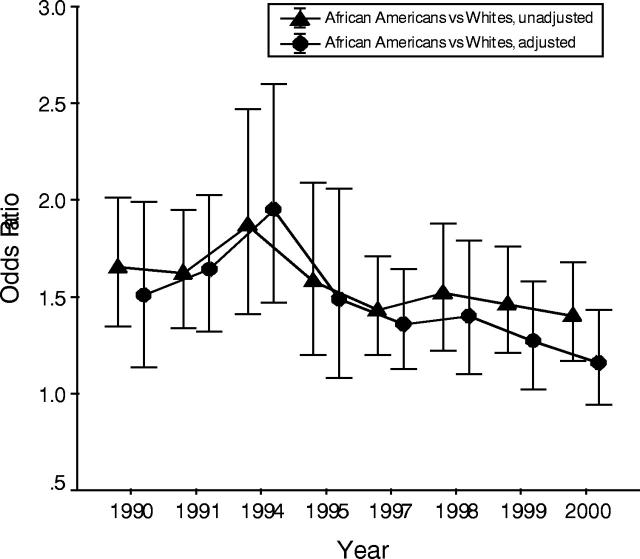Abstract
Objectives. We examined disparities in smoking cessation rates between African Americans and Whites from 1990 through 2000.
Methods. We performed an analysis of smoking cessation with data from the National Health Interview Surveys of 30660 African Americans and 209828 Whites, 18 to 64 years old, with adjustment for covariates in multiple logistic regression models.
Results. Whites were significantly more likely than African Americans to be former smokers, and this disparity in the quit ratio persisted from 1990 through 2000. After adjustment for covariates, disparities were substantially reduced especially among women. Among former smokers, African Americans were significantly more likely than Whites to have quit successfully within the past 10 years.
Conclusions. Statistical adjustment for covariates reduces African American–White disparities in quit ratios, and recent cessation patterns suggest possible future reductions in disparities.
Previous studies in the United States have shown that tobacco consumption has generally decreased among all racial/ethnic groups.1,2 Although prevalence had been higher in African Americans than in Whites since at least 1965,3 recent data indicate that the proportions of current smokers are now similar.1 Among African Americans, smoking prevalence has not decreased uniformly across all demographic groups (e.g., gender, nativity, and region).2,4,5
Rather than “racial/ethnic group,” the term “racially classified social group” (RCSG) was employed in this article to emphasize that “race-ethnicity” as self-reported by survey respondents is not viewed as a biological or genetic construct with implications of immutable group differences based on phenotypic observations such as skin color. The idea of human populations as social groups recognizes the social character of human evolution and diversity rather than the classifications upon which fixations of “race biology” are imputed.6–8
Since the mid-1980s, public health efforts have increasingly promoted cessation initiatives targeting African Americans.9,10 Epidemiological research on smoking cessation has revealed that African Americans are less likely than Whites to make successful quit attempts,1,11 although they are no less likely to want to quit.10,12,13 A study of National Health Interview Survey (NHIS) data found increasing quit ratios from 1965 to 1991 for both African Americans and Whites as well as a persistent difference between these 2 groups.14 Pierce et al., in an analysis of 1974–1985 NHIS data, found a greater disparity in the rate of change in smoking cessation between African American and White men than that of African American and White women.15 In contrast, a longitudinal study during 1985–1995 of young adults (18–35 years old) in 4 cities by Kiefe et al. did not find an African American–White difference in cessation after control for socioeconomic status.16 An analysis of the influence of gender and race/ethnicity on cessation (which did not control for socioeconomic status) concluded that the age of initiation could obscure differences in cessation behavior.17 Intervention studies and clinical trials have observed different outcomes in the quitting behavior of African Americans and Whites.18–20 Some researchers have found effective pharmacological treatment targeting African Americans,21 whereas others have suggested genetic explanations for these variations.6,22–25
To our knowledge, ours is the first study to analyze differences in the quitting behavior of African American and White Americans during 1990–2000. Using NHIS data for 1990 to 2000, our study examined different measures of quitting behavior and explored differences between African Americans and Whites. One implication of this analysis is that it may foreshadow future rates of smoking-related diseases and health disparities. The results may also be useful in developing more effective policies and interventions targeting specific groups of smokers.
METHODS
The NHIS is a national cross-sectional household survey of health behavior consisting mostly of personal interviews of noninstitutionalized civilians. The survey has a stratified cluster probability sample design that oversamples African Americans and Hispanics. Additional information about the design of the NHIS has been previously reported.26,27
Although the NHISs are not longitudinal surveys, the multiple-year cross-sectional data they yield may indicate general trends. The specific NHIS data sets used in this analysis are 1990, 1991, 1993–1995, and 1997–2000 (Table 1 ▶). Data for 1992 were excluded because they consisted of 2 different surveys (i.e., Cancer Epidemiology and Cancer Control Supplements) with dissimilar variables. The 1993 data set did not include complete information about smoking cessation and thus could not be used for all analyses. The 1996 NHIS did not collect complete data about adult smoking behavior. The age range of respondents was 18 to 64 years. The sample did not include Hispanics and consisted of 30 660 African Americans and 209 828 Whites. Annual sample sizes ranged from 2138 to 4785 for African Americans and from 14 632 to 33 949 for Whites.
TABLE 1—
Proportions of Never, Former, and Current Smokers, by Racially Classified Social Group: 1990–2000
| 1990** | 1991** | 1993** | 1994** | 1995** | 1997** | 1998** | 1999** | 2000** | Average | Point Difference | Mean Difference | |
| Never smokers | ||||||||||||
| African American | 57.0 | 57.3 | 58.3 | 58.3 | 59.6 | 59.6 | 61.1 | 60.2 | 62.8 | 59.4 | 5.8 | 10.7 |
| White | 47.4 | 48.9 | 47.6 | 46.4 | 48.5 | 49.1 | 49.4 | 49.9 | 50.9 | 48.7 | 3.5 | |
| Former smokers | ||||||||||||
| African American | 16.8 | 12.2 | 15.8 | 14.6 | 14.5 | 13.7 | 14.1 | 15.5 | 13.9 | 14.6 | –2.9 | –11.2 |
| White | 26.8 | 23.8 | 27.0 | 27.3 | 26.0 | 25.6 | 25.6 | 25.8 | 25.0 | 25.8 | –1.8 | |
| Current smokers | ||||||||||||
| African American | 26.2 | 30.5 | 26.0 | 27.2 | 25.9 | 26.8 | 24.8 | 24.3 | 23.3 | 26.1 | –2.9 | 0.6 |
| White | 25.8 | 27.3 | 25.4 | 26.3 | 25.6 | 25.3 | 25.0 | 24.3 | 24.1 | 25.5 | –1.7 | |
| Ever smokers | ||||||||||||
| African American | 43.0* | 42.7* | 41.7* | 41.7* | 40.4* | 40.4* | 38.9* | 39.8** | 37.2** | 40.7 | –5.8 | –10.6 |
| White | 52.6 | 51.1 | 52.4 | 53.6 | 51.5 | 50.9 | 50.6 | 50.1 | 49.1 | 51.3 | –3.5 | |
Note. All proportions were rounded. Average proportion refers to the mean for all years combined (1990–2000). Point difference is the proportion in 2000 minus the proportion in 1990. Mean difference is the average proportion of African Americans minus the average proportion of Whites. Ever smokers consisted of both former and current smokers.
*P < .01; **P < .001. The 2 sets of P values were based on χ2 analysis of (a) never, former, and current smokers, and (b) never and ever smokers.
Most epidemiological analyses of cessation have been limited to self-report data. Studies have generally found self-report to be valid even when compared with biochemical measures, although some differences in misclassification have been observed between African Americans and Whites.28,29
The quit ratio is conventionally defined as the proportion of ever smokers (i.e., current and former) who are former smokers.17,30 Although frequently used as a point prevalence estimate of cessation in cross-sectional studies, the conventional quit ratio (CQR) has been found to be problematic.17 The proportion of ever smokers who quit for at least 12 months was used as the successful quit ratio (SQR), as 1 year of complete cessation is generally recognized as a “gold standard” in determining successful quitting.3,30 Most of the analyses of quit ratios are limited to the SQR.
In view of the historical difference in cessation rates between African Americans and Whites, we analyzed more recent versus longer durations of successful quitting. The recency of successful quitting (i.e., for 1 year or more) among former smokers was categorized as 10 years or fewer versus more than 10 years (from the time of the NHIS interview), as our analysis showed that there were no differences in study results between quitting in the past 1 to 5 years and quitting in the past 1 to 10 years. The 10-year threshold or interval has also been used by other investigators.1,3,16,31 For individual survey years between 1990 and 2000, we calculated the proportion of former smokers who successfully quit within the last 10 years, as it extended our analysis before the 1990s.
The independent categorical variables were gender, age (18–24 years, 25–34 years, 35–44 years, 45–54 years, and ≥ 55 years), education (less than high school, high school graduate, and some college or more), marital status (married and nonmarried), and geographic regions (Northeast, South, Midwest, and West, based on the standard US census classification). Annual family income was not included in the analysis because missing data, although greater for African Americans, was high for both RCSGs during the earlier part of the decade. For example, between 1990 and 1995, on average, 13.2% of income data were missing for Whites compared with 19.5% for African Americans. Also, in some other NHIS multivariate analyses2,5 and other smoking studies,15 income has not been shown to be a significant or strong predictor of quitting when paired with education among African Americans.
The SAS32 and the SUDAAN33 computer programs were used for data analysis. SUDAAN was used to calculate the correct standard errors for the complex survey design of the NHIS. In implementing SUDAAN, the mildly conservative option used the “With Replacement” design with the “Logistic Procedure.” Output from the program included the standard error of the logistic regression coefficient, the quit ratios, confidence intervals, and the “design effect,” calculated as the ratio of the variance of the estimator to the variance of the estimator assuming a simple random sample.33 Odds ratios and 95% confidence limits for the odds ratios were also obtained. Cross-tabulations were used to assess bivariate relationships between the response variables and the sociodemographic predictors (i.e., age, gender, education, geographic region, and marital status) included in the multivariate analyses.
For Figures 1 ▶ and 2 ▶, yearly point prevalences for various quit ratios and proportions are plotted over time for the RCSG. Each piecewise linear graph or profile is compared with other profiles by using a log-linear model, where the response variable is dichotomous (e.g., quit smoking: yes, no) and the independent variables are year, and the selected factors are RCSG (Figure 1a ▶), combination of RCSG and gender (Figure 1b ▶), or a combination of RCSG and age (Figure 1c ▶). A full model, for example, would include the main effects of racially classified social group and year, as well as the RCSG-by-year interaction. A main effect model would consist solely of year and RCSG. A conservative procedure using the standard error (SE) and the design effects from SUDAAN were included in the log-linear model to compute an “effective” sample size because of the complex survey design, as follows in the next paragraph.
FIGURE 1—
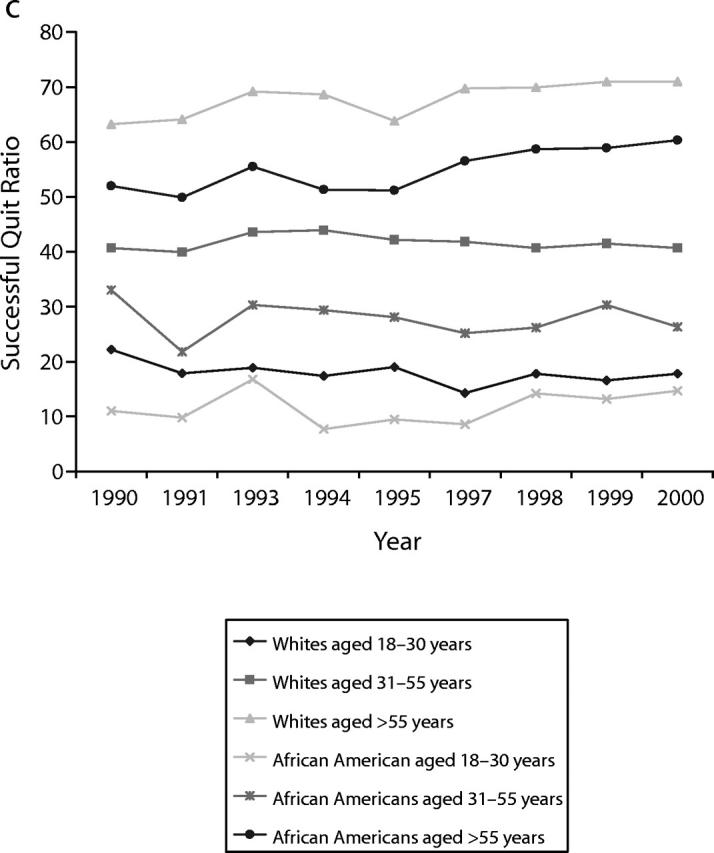
Conventional and successful quit ratios, 1990–2000, by (a) RCSG, (b) RCSG and gender, and (c) RCSG and age.
Note. RCSG = racially classified social group; CQR = conventional quit ratio; SQR = successful quit ratio.
FIGURE 2—
Percentage of successful quitters who quit within the past 10 years, 1990–2000, by racially classified social group and gender.
In discerning the presence of an RCSG-by-time interaction, a exact procedure is cumbersome because of the problems associated with combining multiple years of NHIS data. Moreover, as noted in Botman and Jack,27 it is not possible to model the correlation over time for some primary sampling units, which occur every year in the NHIS survey. Instead, the approach here estimates the frequency of quitters versus nonquitters by using the SE and design effect (DEFF) output from each year separately. Specifically, and by definition, DEFF = SE × SE/VARSRS, where VARSRS is the variance of a simple random sample. For binomial sampling, VARSRS = QR × (1 – QR)/ ne, where QR represents the quit rate expressed as a proportion and ne is the associated effective sample size. To illustrate, consider the conventional quit ratios profile in Figure 1 ▶, 1990, where the unweighted sample size for African Americans is 5452, the QR = 0.39, the SE of the QR is 0.0136 (1.36%), with a DEFF of 1.86. Then, VARSRS = 0.00009944 and ne = 2393, so the associated sample size for the log-linear model would be 0.39 × 2393 = 934 quitters and 2393 – 934 = 1459 nonquitters. For the log-linear model, the SAS PROC CATMOD procedure was used.
For the multiple logistic regression (MLR) analysis, 3 separate models were constructed using the following dependent variables: (1) current versus former smoker; (2) current versus former smokers by RCSG and gender; and (3) former smokers who successfully quit within 10 years of an NHIS survey year (more recently) compared with more than 10 years (longer term cessation). Age of initiation was only available for a limited number of NHIS years. It was used as a covariate for the years 1997–2000 in the model assessing successful quitting among former smokers.
RESULTS
Sociodemographic characteristics of African Americans and Whites remained stable throughout the 1990–2000 period, and the distributions were fairly consistent with the US Bureau of Census estimates between 1990 and 2000.
The proportion of former smokers among African Americans is on average 57% (14.6/ 25.8) the rate of Whites and declined by 2.9% (compared with 1.8% for Whites) from 1990 to 2000 (Table 1 ▶). However, the proportion of African American never smokers was on average 10.7% higher than for Whites and increased 5.8% over the decade compared with a 3.5% increase for Whites. As shown in Table 1 ▶, African Americans consistently had a lower proportion of ever smokers and experienced a larger decrease in ever smokers over the study period compared with Whites.
Also, the rate of smoking decreased 2.9% and 1.7%, respectively, for African Americans and Whites (Table 1 ▶). The mean ratio of former smokers to current smokers from 1990 to 2000 was 0.56 for African Americans and 1.01 for Whites. Thus, the proportion of never smokers was higher among African Americans, but the proportion of former smokers was lower, resulting in similar RCSG smoking prevalence rates.
Although annual fluctuations were observed (Figure 1a ▶), there was a 1.6% decrease in the CQR of African Americans between 1990 and 2000, and the disparity in the CQR between African Americans and Whites at the beginning of the decade (11.9) increased by the year 2000 (13.5). For any given survey year, the SQR pattern was similar but 2 to 8 points lower than the CQR. Log-linear models (not shown) indicated that, for the SQR, the year-by-RCSG interaction approached statistical significance (P=.07), with a highly significant year and RCSG effect. If 1991 (an atypical year) was deleted, both the year and the RCSG-by-year interaction would no longer be significant. However, there was a highly significant RCSG effect (χ2=412, P<.0001).
Figure 1b ▶ presents gender and RCSG successful quit ratios and indicates that White men have the highest SQRs, and this pattern is consistent for the entire decennial. African American women have the lowest SQR of any gender and RCSG.
As shown in Figure 1c ▶, compared with African Americans, Whites had a higher SQR in each age category. Notably, the SQRs were highest for those older than 55 years for both African Americans and Whites and generally increased through the decade. Although there was a small but significant age-by-year interaction, age effects predominate, with each pair of age groups being significantly different, using contrasts in the main effects log-linear model (P < .0001).
Figure 2 ▶ presents the proportion of successful quitters who quit recently (i.e., within the last 10 years) of any given NHIS between 1990 and 2000 by RCSG and gender. For all groups, there was a general decline in the percentage of successful quitters who quit within the past 10 years. In 2000, cross-sectional results showed that African Americans had a significantly higher proportion than Whites of recent successful quitters between 1990 and 2000. In the full model, there were no significant interactions with year. In the reduced model (year, RCSG, gender, RCSG-by-gender), year was highly significant (χ2=453, P< .0001), indicative of a general decline over time for all groups. In the reduced model, there was a relatively small RCSG-by-gender interaction (χ2=11.2, P=.0008), partly indicated by the fact that African American men had much lower SQRs than women in 1997. There were highly significant main effects of RCSG (χ2=170, P<.0001) and gender (χ2= 66.7, P<.0001) as, overall, African Americans had a higher proportion of successful quitters who quit within the 10 years preceding any NHIS year than Whites, and women had a higher proportion than men.
The adjusted odds ratios for MLR models for each year predicting former versus current smokers are presented in Figure 3a ▶. In each year, Whites compared with African Americans were significantly more likely to be former smokers than current smokers. In separate models of men and women examining former versus current smoking status (Figure 3b ▶), the adjusted odds ratios of White versus African American men generally declined after 1994, indicating greater parity between these groups. The adjusted odds ratios for White versus African American women were not statistically significant in 3 of the 4 years between 1990 and 1994 but were not significant in 3 of the 5 later years (1995–2000).
FIGURE 3—
Odds ratios for being a former vs current smoker, 1990–2000, among (a) Whites vs African Americans (adjusted and unadjusted) and (b) Whites vs African Americans (adjusted) for women vs men separately.
Note. Adjusted for covariates, age, gender, education, marital status, and geographic region.
Among former smokers, the unadjusted and adjusted odds ratios show that African Americans were significantly more likely than Whites to have successfully quit within 10 years before each NHIS (Figure 4 ▶) for every year except 2000. This general pattern varied when separate models were run by gender. Additional MLR analyses using age of initiation as a covariate for the years 1997–2000 did not affect the results (data not shown).
FIGURE 4—
Adjusted and unadjusted odds ratios among African American vs White former smokers for having successfully quit ≤ 10 years ago vs > 10 years ago, 1990–2000.
DISCUSSION
Research on tobacco use and health disparities requires complex analyses so as not to obscure, overstate, or simplify differences. Our study’s findings revealed both positive developments (i.e. quitting behavior within the past 10 years for African American former smokers) and continuing challenges in closing the smoking cessation gap between African Americans and Whites. Between 1990 and 2000, African Americans had a much lower annual average of former smokers (14.6%) than did Whites (25.8%), and this disparity increased slightly at the end of the decade. Using the higher standard of the SQR, we did not find any attenuation in the African American–White disparity between 1990 and 2000, nor did we find a significant RCSG-by-year interaction effect when 1991 (an outlier year) was excluded.
Over the past decennial period, as larger percentages of African Americans (59.4% annual average compared with 48.7% for Whites) have refrained from becoming smokers, the prevalence of current smokers (even with the overall decline in African American former smokers) has diminished. Studies have attributed this pattern largely to cultural and social influences (e.g., parental prohibitions, social norms) that have limited smoking initiation among African American teenagers, women, and nonnative populations and in certain geographic regions.2,4,5,34,35 These results also suggest that cultural preventive influences have been more effective than cessation in reducing current smoking among African Americans.
The MLR models revealed that for each year, Whites were more likely to be former smokers compared with African Americans; however, for most of the post-1994 period, the adjusted odds ratios of African Americans and Whites for former versus current smokers were less than 1.5 (Figure 3a ▶) and were not statistically significant in women for most years (Figure 3b ▶). Also, adjusted findings showed that the odds ratios of African American and White men with respect to quitting continued to decline after 1994. Among former smokers, the finding that African Americans were more likely to have quit smoking for at least 1 year within the 10 years previous to each NHIS between 1997 and 2000 might portend future improvement in quit ratios and smoking prevalence among African Americans (Figure 4 ▶).
We speculate that as a greater number of older African American smokers die, it is likely that the pool of future smokers will be smaller and younger. It is possible that these individuals will make more successful attempts to quit because of less severe physiological addiction, improved socioeconomic status, greater concern about the consequences of smoking, and better access to cessation therapies. This proposition is consistent with studies that have observed a leveling off or reduction in gains via cessation36,37 as well as the size and the characteristics of the “hard-core” smoker population.34 It is also likely that cultural influences could have a considerable impact (e.g., changes in social norms about quitting, greater community effort and social network support to stop smoking) on future patterns of cessation among African Americans.
Although African American–White differences in cessation continue to exist, they are reduced considerably if not eliminated after statistical adjustment for sociodemographic factors. Our results, like those of other researchers,22–25 do not support genetic explanations for African American–White differences in quitting. Disparities in smoking cessation among RSCG are strongly influenced by socioeconomic status6,12,15,16,38,39 and do not appear to be a fixed attribute reflecting biological or genetic differences between African Americans and Whites.
Our analysis has a number of important strengths. First, we are not aware of any other studies that have analyzed cessation patterns between African Americans and Whites for most of the years between 1990 and 2000. Second, we used the higher standard of cessation (i.e., 1-year SQR) and used multiple-year nationally representative samples that included a large number of African Americans. In addition, we adjusted for sociodemographic covariates to assess the disparity in cessation, although we could not adjust for racial discrimination or racism, as these variables were not collected by the NHIS.
This study also has several limitations. First, NHIS data on cessation are derived from self-report, and although there is evidence to support the validity of self-reported smoking measures, there may be some differences in reporting of cessation.28,29 Second, as noted earlier, these data are from annual cross-sectional samples and are not cohort or longitudinal studies, and therefore considerable caution must been exercised regarding any causal or temporal inferences.26,27
Third, quitting behavior has been shown to be inversely related to the number of cigarettes consumed per day, and African Americans smoke on average fewer cigarettes daily than Whites1; however, data on the number of cigarettes smoked at the time of quitting were not collected by the NHIS for former smokers. Fourth, we note that recidivism among former smokers could potentially affect the results from year to year.40,41 Fifth, data from the NHIS are based on noninstitutionalized populations and excluded persons such as incarcerated individuals,2,5 a population that includes a disproportionate number of African American men who are likely to have higher-than-average smoking rates. If these populations were counted, the quit ratios would likely be lower than estimates derived from the NHIS, and smoking prevalence rates would probably be higher.
It should be noted that quit ratios are crude indicators that are typically unadjusted for sociodemographic differences, and they do not explain disparities by RCSG. Also, because many former smokers stopped long ago, quit ratios reflect recent patterns of quitting as well as long-term cessation trends,2,17 and the ratios of Whites have been higher historically than those of African Americans.
Moreover, neither the quit ratios nor other analyses account for a factor that may systematically overestimate quitting by time period among African Americans in cross-sectional studies, namely, the impact of excess mortality. Because of the disproportionately greater mortality from lung cancer and some other smoking-related diseases (especially among African American men),42,43 the denominators (i.e., ever smokers) of the quit ratios for African Americans are likely to be proportionally smaller than those of Whites. As a result, such estimates of cessation may artificially inflate the rate of quitting among African Americans. The problem of overestimation would be relatively less important at younger ages (as shown in Figure 2b ▶) because the effect of African American–White differences in mortality from smoking-related diseases would be less relevant. Analyses based on longitudinal data are needed to account for the differential in mortality.
The process of cessation is both an individual and a collective experience. On the individual level, social, physiological, and psychological factors converge to motivate people to stop smoking, sustain them through the withdrawal process, and help them to resist the temptation to relapse.44 On the collective or societal level, public policies regarding tobacco control (i.e., excise taxes, restrictions of sales, smoking prohibitions), social institutions (e.g., medical and health organizations, schools), innovations in cessation strategies (e.g., nicotine-replacement therapies, media communications), and organizations (e.g., unions, antismoking coalitions, civic groups) have contributed to a broad social consensus against tobacco consumption in American society.1 During the past decade and longer, public health efforts have increasingly targeted high rates of smoking among African American adults9,44,45 with community-based interventions (both prevention and cessation) emphasizing multidisciplinary and culturally appropriate strategies.
In addition, many African American communities have engaged in activism against tobacco industry promotional campaigns (e.g., Uptown brand cigarettes and billboard advertisements in minority communities) and in community awareness projects that have stimulated debate as well as alliances between African American social, civic, and health organizations.26,46,47 For the foreseeable future, differences in quitting as conventionally measured will likely persist, because the historical imbalances and sociodemographic correlates of quitting may not be quickly or easily rectified. In addition to the longer-term goal of eliminating social inequities, addressing the disparity in cessation will require more immediate strategies such as increasing the number of cost-effective and accessible interventions targeting specific groups of African Americans.
Acknowledgments
This article was supported in part by the Minority International Research Training Program of the Fogarty International Center (grant 5 T37 TW00113-05).
The authors would like to acknowledge Farzad Noubary and Paul Mowery for their substantive comments on earlier drafts of the article. We also thank Ellen Humphrey and Tamika Gilreath for their editorial assistance.
Human Participant Protection No institutional review board approval was required; this article involved only secondary data analysis.
Peer Reviewed
Contributors G. King originated the study and participated in planning, analysis, and writing. A. Polednak helped in planning, analysis, and writing. R. B. Bendel provided statistical support and helped to write the document. M. C. Vilsaint and S. B. Nahata conducted the data analysis.
References
- 1.Tobacco Use Among U.S. Racial/Ethnic Minority Groups—African Americans, American Indians, and Alaska Natives, Asian Americans and Pacific Islanders, and Hispanics: A Report of the Surgeon General. Atlanta, Ga: US Dept of Health and Human Services; 1998. [PubMed]
- 2.King G, Bendel R, Delaronde SR. Social heterogeneity in smoking among African Americans. Am J Public Health. 1998;88:1081–1085. [DOI] [PMC free article] [PubMed] [Google Scholar]
- 3.Reducing the Health Consequences of Smoking: 25 Years of Progress. A Report of the Surgeon General. Atlanta, Ga: US Dept of Health and Human Services, Public Health Service, Centers for Disease Control, Center for Chronic Disease Prevention and Health Promotion, Office on Smoking and Health; 1989. DHHS publication CDC 89–8411.
- 4.King G, Polednak A, Bendel R, Hovey D. Smoking among native and foreign-born African Americans. Ann Epidemiol. 1999;9:236–244. [DOI] [PubMed] [Google Scholar]
- 5.King G, Polednak T, Bendel R. Regional variation in smoking among African Americans. Prev Med. 1999;29:126–132. [DOI] [PubMed] [Google Scholar]
- 6.King G. The “race” concept in smoking: a review of the research on African Americans. Soc Sci Med. 1997;45:1075–1087. [DOI] [PubMed] [Google Scholar]
- 7.Goodman AH. Why genes don’t count (for racial differences in health). Am J Public Health. 2000;90:1699–1702. [DOI] [PMC free article] [PubMed] [Google Scholar]
- 8.Kaplan JB, Bennett T. Use of race and ethnicity in biomedical publications. JAMA. 2003;289:2709–2716. [DOI] [PubMed] [Google Scholar]
- 9.Stotts RC, Glynn TJ, Baquet CR. Smoking cessation among blacks. J Health Care Poor Underserved. 1991;2:307–319. [DOI] [PubMed] [Google Scholar]
- 10.Pederson LL, Ahluwalia JS, Harris KJ, McGrady GA. Smoking cessation among African Americans: what we know and do not know about interventions and self-quitting. Prev Med. 2000;31:23–38. [DOI] [PubMed] [Google Scholar]
- 11.Fiore MC, Bailey WC, Cohen SJ, et al. Smoking Cessation Clinical Guideline No. 18. Rockville, Md: US Dept of Health and Human Services, Public Health Service, Agency for Health Care Policy and Research; 1996. AHCPR publication 96–0692.
- 12.Royce JM, Hymowitz N, Corbett K, Hartwell TD, Orlandi MA. Smoking cessation factors among African Americans and whites. Am J Public Health. 1993;83:220–226. [DOI] [PMC free article] [PubMed] [Google Scholar]
- 13.Ahluwalia JS. Smoking cessation in African-Americans. Am J Health Behav. 1996;20:312–318. [Google Scholar]
- 14.Giovino GA, Schooley MW, Zhu BP, et al. Surveillance for selected tobacco-use behaviors: United States, 1990–1994. MMWR CDC Surveill Summ. 1994;43:1–43. [PubMed] [Google Scholar]
- 15.Pierce JP, Fiore MC, Novotny TE, Hatziandreu EJ, Davis RM. Trends in cigarette smoking in the United States: education differences are increasing. JAMA. 1989;261:56–60. [PubMed] [Google Scholar]
- 16.Kiefe CI, Williams OD, Lewis CE, Allison JJ, Sekar P, Wagenknecht LE. Ten-year changes in smoking among young adults: are racial differences explained by socioeconomic factors in the CARDIA study? Am J Public Health. 2001;91:213–218. [DOI] [PMC free article] [PubMed] [Google Scholar]
- 17.McGrady GA, Pederson LL. Do sex and ethnic differences in smoking initiation mask similarities in cessation behavior? Am J Public Health. 2002;92;961–965. [DOI] [PMC free article] [PubMed] [Google Scholar]
- 18.Kabat GC, Morabia A, Wynder EL. Comparison of smoking habits of blacks and whites in a case-control study. Am J Public Health. 1991;81:1483–1486. [DOI] [PMC free article] [PubMed] [Google Scholar]
- 19.Royce JM, Hymowitz N, Corbett K, Hartwell, TD, Orlandi MA. Smoking cessation factors among African Americans and whites: COMMIT Research Group. Am J Public Health. 1993;83:220–226. [DOI] [PMC free article] [PubMed] [Google Scholar]
- 20.Wagenknecht LE, Craven TE, Preisser JS, Manolio TA, Winders S, Hulley SB. Ten-year trends in cigarette smoking among young adults, 1986–1996: The CARDIA Study. Coronary Artery Risk Development In Young Adults. Ann Epidemiol. 1998;8:301–307. [DOI] [PubMed] [Google Scholar]
- 21.Ahluwalia JS, Harris KJ, Catley D, Okuyemi KS, Mayo MS. Sustained-release bupropion for smoking cessation in African Americans: a randomized controlled trial. JAMA. 2002;288:468–474. [DOI] [PubMed] [Google Scholar]
- 22.Wagenknecht LE, Cutter GR, Haley NJ, et al. Racial differences in serum cotinine levels among smokers in Coronary Artery Risk Development in (Young) Adults study. Am J Public Health. 1990;80:1053–1056. [DOI] [PMC free article] [PubMed] [Google Scholar]
- 23.Caraballo RS, Giovino GA, Pechacek TF, et al. Racial and ethnic differences in serum cotinine levels of cigarette smokers: Third National Health and Nutrition Examination Survey, 1988–1991. JAMA. 1998;280:135–139. [DOI] [PubMed] [Google Scholar]
- 24.Perez-Stable EJ, Herrera B, Jacob P III, Benowitz NL. Nicotine metabolism and intake in black and white smokers. JAMA. 1998;280:152–156. [DOI] [PubMed] [Google Scholar]
- 25.Ahijevych KL, Wewers ME. Patterns of cigarette consumption and cotinine levels among African American women smokers. Am J Respir Crit Care Med. 1994;150:1229–1233. [DOI] [PubMed] [Google Scholar]
- 26.Sample Design and Estimation Procedures for the National Health Interview Survey, 1985–1994. Hyattsville, Md: National Center for Health Statistics; 1989. DHHS publication PHS 89-1384.
- 27.Botman SL, Jack SS. Combining National Health Interview Survey Datasets: issues and approaches. Stat Med. 1995;14:669–677. [DOI] [PubMed] [Google Scholar]
- 28.Patrick DL, Cheadle A, Thompson DC, Diehr P, Koepsell T, Kinne S. The validity of self-reported smoking: a review and meta analysis. Am J Public Health. 1994;84:1086–1093. [DOI] [PMC free article] [PubMed] [Google Scholar]
- 29.Wagenknecht LE, Burke GL, Perkins LL, Haley NJ, Friedman GD. Misclassification of smoking status in the CARDIA study: a comparison of self-report with serum cotinine levels. Am J Public Health. 1992;82:33–36. [DOI] [PMC free article] [PubMed] [Google Scholar]
- 30.Gilpin EA, Pierce JP, Farkas AJ. Duration of smoking abstinence and success in quitting. J Natl Cancer Inst. 1997;89:572–576. [DOI] [PubMed] [Google Scholar]
- 31.Coambs RB, Li S, Kozlowski LT. Age interacts with heaviness of smoking in predicting success in cessation of smoking. Am J Epidemiol. 1992;135:240–246. [DOI] [PubMed] [Google Scholar]
- 32.Allison P. Logistic Regression Using the SAS System: Theory and Application. Cary, NC: SAS Publications, SAS Institute; 1999.
- 33.Shah BV, Barnwell BG, Bieler GS. SUDAAN User’s Manual Release 7.5. Research Triangle Park, NC: Research Triangle Institute; 1997.
- 34.Emery S, Gilpin EA, Ake C, Farkas AJ, Pierce JP. Characterizing and identifying “hard-core” smokers: implications for further reducing smoking prevalence. Am J Public Health. 2000;90:387–394. [DOI] [PMC free article] [PubMed] [Google Scholar]
- 35.Faulkner DL, Escobedo LG, Zhu B, Chrismon JH, Merritt RK. Race and the incidence of smoking among adolescents in the United States. J Natl Cancer Inst. 1996:88:1158–1160. [DOI] [PubMed] [Google Scholar]
- 36.Giovino GA, Henningfield JE, Tomar SL, Escobedo LG, Slade J. Epidemiology of tobacco use and dependence. Epidemiol Rev. 1995;17:48–65. [DOI] [PubMed] [Google Scholar]
- 37.Mendez D, Warner KE, Courant PN. Has smoking cessation ceased? Expected trends in the prevalence of smoking in the United States. Am J Epidemiol. 1998;148:249–258. [DOI] [PubMed] [Google Scholar]
- 38.McCarthy WJ, Caskey NH, Jarvik ME. Ethnic differences in nicotine exposure. Am J Public Health. 1992;82:1171–1173. [DOI] [PMC free article] [PubMed] [Google Scholar]
- 39.Flint AJ, Novotny TE. Poverty status and cigarette smoking prevalence and cessation in the United States, 1983–1993: the independent risk of being poor. Tob Control. 1997;6:14–18. [DOI] [PMC free article] [PubMed] [Google Scholar]
- 40.Ockene JK, Emmons KM, Mermelstein RJ, et al. Relapse and maintenance issues for smoking cessation. Health Psychol. 2000;19:17–31. [DOI] [PubMed] [Google Scholar]
- 41.Taylor DH, Hasselbad V, Henley SJ, Thun MJ, Sloan FA. Benefits of smoking cessation for longevity. Am J Public Health. 2002;92:990–996. [DOI] [PMC free article] [PubMed] [Google Scholar]
- 42.Northridge ME, Morabia A, Ganz ML, et al. Contribution of smoking to excess mortality in Harlem. Am J Epidemiol. 1998;147:250–258. [DOI] [PubMed] [Google Scholar]
- 43.Jemal A, Chu KC, Tarone RE. Recent trends in lung cancer mortality in the United States. J Natl Cancer Inst. 2001;93:277–283. [DOI] [PubMed] [Google Scholar]
- 44.Prochaska JO, Velicer WF. The transtheoretical model of health behavior change. Am J Health Promot. 1997;12:38–48. [DOI] [PubMed] [Google Scholar]
- 45.Orleans CT, Schoenbach VJ, Salmon MA, et al. A survey of smoking and quitting patterns among black Americans. Am J Public Health. 1989;79:176–181. [DOI] [PMC free article] [PubMed] [Google Scholar]
- 46.Lacey LP, Manfredi C, Balch G, Warnecke RB, Allen K, Edwards C. Social support in smoking cessation among black women in Chicago public housing. Public Health Rep. 1993;108:387–394. [PMC free article] [PubMed] [Google Scholar]
- 47.Ellis GA, Reed DF, Scheider H. Mobilizing a low-income African American community around tobacco control: a force field analysis. Health Educ Q. 1995;22:443–457. [DOI] [PubMed] [Google Scholar]



